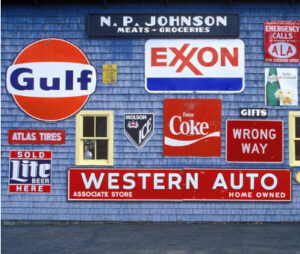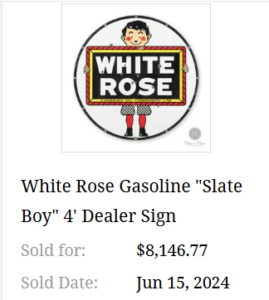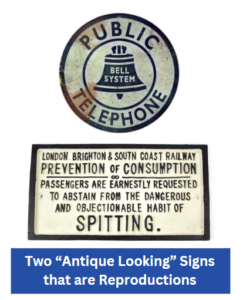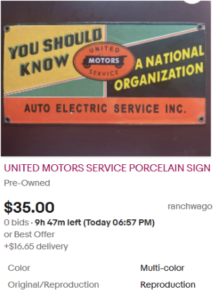Collecting vintage signs has become an incredibly popular hobby—and for good reason. Signs from old gas stations, general stores, and brands like Coca-Cola, Texaco, and Mobil carry a sense of nostalgia and history that’s hard to replicate. Original signs can fetch thousands of dollars at auctions and in private sales.
But in recent years, more and more fakes have started flooding the market (primarily from overseas). Worse yet, the quality of these reproductions is improving, making it harder even for experienced collectors to tell the difference. Knowing how to spot a fake is more important than ever if you want to avoid overpaying for a reproduction.
Here’s a detailed guide to help you separate the genuine pieces from the clever knockoffs.

Why Vintage Signs Are Valuable
Historical Value – Signs from the early to mid-20th century reflect the branding and advertising styles of their time.
Scarcity – Many signs were discarded over the years, so surviving pieces are rare.
Beauty & Decorative Appeal – Vintage signs add character to homes, bars, garages, and man caves
Why Fakes & Reproductions Are Becoming More of Problem
- There are More Collectors than Ever – more people are building man caves and creating outdoor bars and places to hang out. This means more demand.
- Increased Demand = Increased Value. There is more demand than ever, which means supply is lower and prices higher. Prices have gotten so high that manufacturers are willing to to invest significant time and effort into making high quality reproductions. Selling $750 signs is much different than $75 signs.
- Technology Has Improved Modern printing and aging techniques have come a long way. What was impossible (or very expensive) 10 years ago can be done relatively easily with the right machines.
- The Sellers Have Changed.
- There are more sellers than ever
- Many of these sellers are less educated
- Some are greedy and are happy to ignore / hide the truth

Types of Replica / Reproduction Signs
1. Mass-Produced, Thin Metal Signs
- Sold openly as reproductions in gift shops, flea markets, and online for as little as $3
- Usually made from lightweight aluminum or tin.
- Often feature bright, glossy finishes with classic designs (like Coca-Cola or Texaco).
- “Aged” Versions – The same thin metal signs are sometimes given an artificial patina (rust, chipped paint, etc.) to make them appear older.
- The aging may look convincing at first, but these signs are easy to spot when handled in person—they’re thin and lightweight, and the “rust” may feel painted on rather than textured.

2. Heavier-Duty Reproductions
- Made from thicker, more durable metal—sometimes steel.
- Artificial aging is more sophisticated, with better-placed rust and wear patterns.
- These can easily fool casual buyers, but close inspection will often reveal modern production methods (laser-cut edges, overly consistent patina).

3. Porcelain and Enamel Reproductions
- This is the most concerning category because porcelain and enamel fakes weren’t widely available until recently. And most consumers (outside collectors) haven’t come across a porcelain sign of any kind before – so when they feel something so heavy and different they immediately think “this must be real”.
- New porcelain reproductions have the glossy, glassy finish of original signs—making them harder to detect visually.
- Often have chipped edges, stains, rust and sometimes aged looking / rusted rivets.

How to Spot Fake Vintage Signs
While fakes are getting better, there are still ways to tell them apart from the real deal. Keep an eye out for these key details:
1. Material and Finish
- Original porcelain and enamel signs have a smooth, glossy finish that reflects light.
- Reproductions may use modern paints that look flat or have an uneven gloss.
- Feel the surface—real porcelain and enamel signs have a distinct cool, glassy feel
2. Rust and Aging Patterns
- Authentic signs develop rust naturally over time, often around the edges, mounting holes, and corners.
- Fakes are now showing more realistic rust, but it may still look too even or uniform.
- Check if the rust “sits” on the surface—true rust will often penetrate and cause some flaking.
- Fakes may have chips or even holes (fake bullet holes are a classic) – but they usually aren’t in the main part of the graphic.
3. Mounting Holes and Grommets
Real signs were often mounted with heavy-duty grommets or rivets.
- Fakers are now using rusted-looking rivets, but the placement might be off or too clean.
- Holes on real signs often show uneven wear from years of being hung up or moved
4. Typography and Graphics
- Genuine signs from the early 20th century were made using hand-cut stencils or screen printing, so the lines might not be perfectly crisp.
- Fakes may have overly sharp or clean edges due to modern printing techniques.
5. Back Side and Edges
- The back of an original sign usually shows wear, rust, and chipped paint.
- Some fakes now distress the back, but it may look staged or too consistent.
- Edges of real signs may have irregularities from being stamped or hand-cut, while fakes tend to have cleaner, machine-cut edges.
6. Weight and Thickness
Authentic porcelain and enamel signs are heavier than modern aluminum or tin reproductions.- Fakes made of lightweight materials may feel too thin or bend more easily.
7. Markings and Stamps
- Many vintage signs had manufacturer stamps or markings on the back or edge.
- Some fakers now add fake markings, but they may be in the wrong font, size, or placement.
- Compare with known examples of manufacturer markings from the same period.
Red Flags to Watch Out For
Even if a fake looks convincing, there are often clues in the buying process that can help you spot trouble:
- Too Good to Be True Pricing – If it’s significantly cheaper than similar signs, be suspicious.
- “Rare” Signs Available in Bulk – If the seller keeps offering the same “rare” sign, it’s almost certainly a reproduction.
- Misleading or Vague Language – Terms like “vintage-style,” “replica,” or “reproduction” buried in the fine print are a red flag. Sometimes “original” is used – but remember that original doesn’t mean it is from 80 years ago. Something made last year might still be labeled original – because perhaps the design is new and original.
Note: Always do your own research and get multiple opinions – there are no “sure fire” rules to prove something is real or reproduction.
